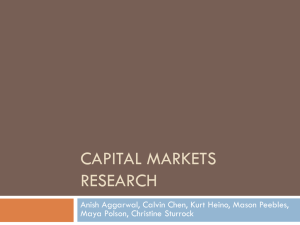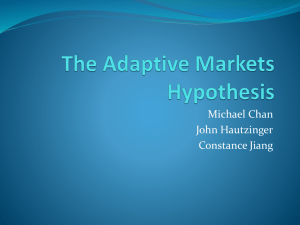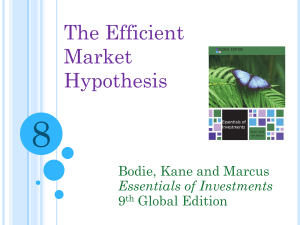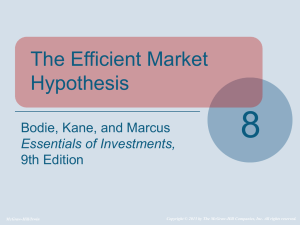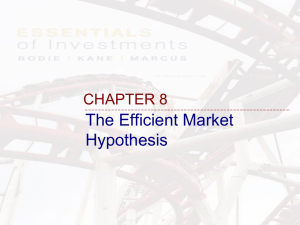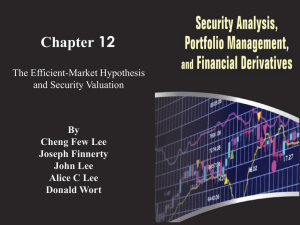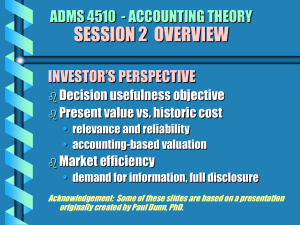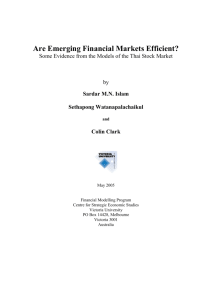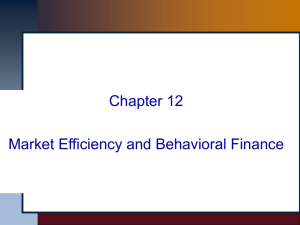EMH - Kian
advertisement
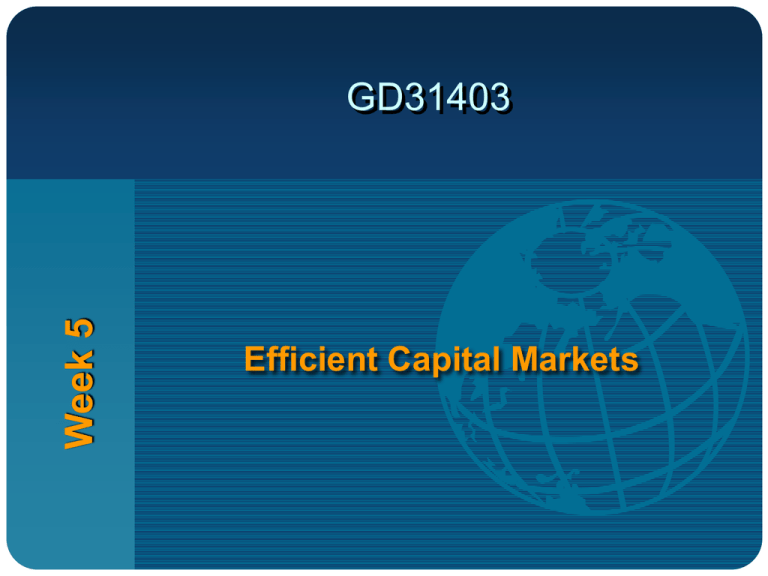
Week 5 GD31403 Efficient Capital Markets Why Should the Markets Be Efficient? • Premises of An Efficient Market – A large number of competing profit-maximizing participants analyze and value securities, each independently of the others – New information regarding securities comes to the market in a random fashion – Profit-maximizing investors adjust security prices rapidly to reflect the effect of new information 6-2 Why Should the Markets Be Efficient? • The Results – Security price changes should be independent and random – The security prices that prevail at any time should be an unbiased reflection of all currently available information – In an efficient market, the expected returns implicit in the current price of a stock should be consistent with the perceived risk of the stock 6-3 Efficient Market Hypotheses (EMH) • Random Walk Hypothesis – Changes in security prices occur randomly • Fair Game Model – Current market price reflect all available information about a security and the expected return based upon this price is consistent with its risk • Efficient Market Hypothesis (EMH) – Divided into three sub-hypotheses depending on the information set involved (Fama, 1970). 6-4 EMH in Fama (1970) (1) Weak-Form EMH – Current prices reflect all security-market historical information, including the historical sequence of prices, rates of return, trading volume data, and other market-generated information – This implies that past rates of return and other market data should have no relationship with future rates of return – In short, prices reflect all historical information 6-5 EMH in Fama (1970) (2) Semi-strong Form EMH – Current security prices reflect all public information, including market and non-market information – This implies that decisions made on new information after it is public should not lead to above-average risk-adjusted profits from those transactions – In short, prices reflect all public information 6-6 EMH in Fama (1970) (3) Strong-Form EMH – Stock prices fully reflect all information from public and private sources – This implies that no group of investors should be able to consistently derive above-average riskadjusted rates of return – This assumes perfect markets in which all information is cost-free and available to everyone at the same time – In short, prices reflect all public & private information 6-7 EMH in Fama (1970) 6-8 Weak: How well do past returns predict future returns? Semi-strong: How quickly do stock prices reflect public information announcement? Strong: Do any investors have private information that is not fully reflected in market price? Tests of Weak-Form EMH (1) Statistical Tests of Independence – Determine whether the asset prices follow a random walk, or more strictly a martingale. – Numerous statistical tests have been employed, e.g. • Autocorrelation tests • Runs tests • Long memory tests • Non-linearity tests 6-9 For a review of the statistical tests, see the survey paper by Lim and Brooks (2011, JES) Tests of Weak-Form EMH (2) Profitability of Technical Trading Rules – Almost infinite number of trading rules – The most common one is filter rules – Use only publicly available data – Include transaction costs (the emphasis is on profitability and not predictability) – Adjust the results for risk 6-10 For a review, see the survey paper by Park and Irwin (2007, JES) Tests of Semi-strong Form EMH Event Studies – Examine how fast stock prices adjust to specific significant economic events or public announcements. – E.g., stock splits, initial public offerings, stock listings, merger & acquisitions, earnings, spinoffs, accounting changes. – If the market is efficient, it would not be possible for investors to derive positive abnormal returns by investing after the release of public announcement. 6-11 Tests of Semi-strong Form EMH Individual Abnormal Returns Surrounding the Event in an Efficient Market -t 6-12 0 Announcement Date = abnormal return +t Tests of Semi-strong Form EMH Individual Abnormal Returns Surrounding the Event in an Inefficient Market -t 6-13 0 Announcement Date +t Tests of Semi-strong Form EMH Abnormal Return (AR) = Actual Return – Expected Return rt = a + b(rindex,t) + et AR = et = rt – [a + b(rindex,t)] 6-14 8-14 Tests of Semi-strong Form EMH In this case there appears to be information leakage before the announcement date (day 0), but markets adjust quickly. 6-15 8-15 Tests of Semi-strong Form EMH 6-16 8-16 Tests of Strong-Form EMH • Strong-form EMH contends that stock prices fully reflect both public and private information • This implies that no group of investors with private information will consistently earn above-average profits • Targeted groups of investors: – – – – 6-17 Corporate insiders Stock exchange specialists Security analysts Professional money managers EMH in Fama (1991) (1) Tests for Return Predictability (formerly Weak-form EMH) – The coverage was expanded beyond past returns. – Include other forecasting variables like dividend yields, earnings yields, interest rates, bond credit spreads. – Examine seasonality in returns like Monday Effect, January Effect, Holiday Effect. – Consider cross-sectional predictors such as bookto-market ratio, size, price-earnings ratio, leverage, liquidity. 6-18 EMH in Fama (1991) 6-19 8-19 EMH in Fama (1991) 6-20 8-20 EMH in Fama (1991) (2) Event Studies (formerly Semi-strong form EMH) – Same coverage. – Only a change in title. 6-21 EMH in Fama (1991) (3) Tests for Private Information (formerly Strong-form EMH) – Same coverage. – Only a change in title. 6-22 Implications of Efficient Capital Markets • Overall, the results of many studies indicate the capital markets are efficient as related to numerous sets of information • On the other hand, there are substantial instances where the market fails to rapidly adjust to public information • What are the implications for investors in light of these mixed evidence? 6-23 – Technical Analysis – Fundamental Analysis – Portfolio Management Implications of Efficient Capital Markets (1) Technical Analysis • Assumptions of technical analysis directly oppose the notion of efficient markets • Technicians believe that new information is not immediately available to everyone, but disseminated from the informed professional first to the aggressive investing public and then to the masses 6-24 • Technicians also believe that investors do not analyze information and act immediately Implications of Efficient Capital Markets • Stock prices move to a new equilibrium after the release of new information in a gradual manner, causing trends in stock price movements that persist for periods of time • Technical analysts develop systems to detect movement to a new equilibrium (breakout) and trade based on that • If the capital market is weak-form efficient, a trading system that depends on past trading data has no value 6-25 Implications of Efficient Capital Markets (2) Fundamental Analysis • Fundamental analysts believe that there is a basic intrinsic value for the aggregate stock market, various industries, or individual securities and these values depend on the underlying economic factors • Investors should determine the intrinsic value of an investment at a point in time and compare it to the market price 6-26 Implications of Efficient Capital Markets • If you can do a superior job of estimating intrinsic value, you can make superior market timing decisions and generate above-average returns • Intrinsic value analysis involves: – Aggregate market analysis – Industry and company analysis 6-27 Implications of Efficient Capital Markets • If intrinsic value > current stock price: - BUY • If intrinsic value < current stock price - SELL • In either case if the analysis is correct, the investor should receive an abnormal return. 6-28 8-28 Implications of Efficient Capital Markets • If the markets are only weak-form efficient, fundamental analysis CAN yield abnormal returns. • If the markets are semi-strong or strong form efficient, then fundamental analysis CANNOT yield abnormal returns. 6-29 Implications of Efficient Capital Markets (3) Portfolio Management • Active Management – Security analysis – Timing strategies – Investment Newsletters • Passive Management – Buy and Hold portfolios – Index Funds Assumes inefficiency, use technical and/or fundamental analysis to pick securities Consistent with semistrong efficiency 6-30 8-30 Implications of Efficient Capital Markets Even if the market is efficient, a role exists for portfolio management – Determine and quantify your client's risk preferences – Construct the appropriate portfolio – Diversify completely on a global basis to eliminate all unsystematic risk – Maintain the desired risk level by rebalancing the portfolio whenever necessary – Minimize total transaction costs 6-31 – Create market (index) funds which duplicate the composition and performance of a selected index series Behavioral Finance • It is concerned with the analysis of various psychological traits of individuals and how these traits affect the manner in which they act as investors, analysts, and portfolio managers • There is no unified theory of behavioral finance and the emphasis has been on identifying portfolio anomalies that can be explained by various psychological traits 6-32 Behavioral Finance Prospect Theory • Contends that utility depends on deviations from moving reference point rather than absolute wealth Overconfidence (confirmation bias) • Look for information that supports their prior opinions and decision Noise Traders • Influenced strongly by sentiment, they tend to move together, which increases the prices and the volatility Escalation Bias • Put more money into a bad investment 6-33 Behavioral Finance Fusion Investing • The integration of two elements of investment valuation: fundamental value & investor sentiment • During some periods, investor sentiment is rather muted and noise traders are inactive, so that fundamental valuation dominates market returns • In other periods, when investor sentiment is strong, noise traders are very active and market returns are more heavily impacted by investor sentiments 6-34 Adaptive Markets Hypothesis (AMH) • With the issue of rationality in human behaviour at the heart of the controversy between the opposing camps of EMH and behavioural finance, Lo (2004) argues that valuable insights can be derived from the biological perspective and calls for an evolutionary alternative to market efficiency. • Lo (2004) proposes the new paradigm of AMH in which the EMH can co-exist alongside behavioural finance in an intellectually consistent manner. 6-35 Adaptive Markets Hypothesis (AMH) Implications of AMH to portfolio management • The equity risk premium varies over time according to the recent stock market environment and the demographics of investors in that environment. • Arbitrage opportunities do arise in the financial markets from time to time. • Investment products undergo cycles of superior and inferior performance in response to changing business conditions, the adaptability of investors, the number of competitors in the industry and the magnitude of profit opportunities available. 6-36 • Survival is ultimately the only objective that matters for the evolution of markets and financial technologies. Adaptive Markets Hypothesis (AMH) Conceptual Papers on AMH Lo, A.W. (2004) The adaptive markets hypothesis: market efficiency from an evolutionary perspective. Journal of Portfolio Management 30(5): 15–29. Lo, A.W. (2005) Reconciling efficient markets with behavioral finance: the adaptive markets hypothesis. Journal of Investment Consulting 7(2): 21–44. Survey Paper on AMH Lim, K.P. and Brooks, R.D. (2011) The evolution of stock market efficiency over time: a survey of the empirical literature. Journal of Economic Surveys 25(1), 69–10. 6-37 Adaptive Markets Hypothesis (AMH) Empirical Papers on AMH Neely, C.J., Weller, P.A. and Ulrich, J. (2009) The adaptive markets hypothesis: evidence from the foreign exchange market. Journal of Financial and Quantitative Analysis 44(2), 467–488. Kim, J.H., Shamsuddin, A. and Lim, K.P. (2011) Stock return predictability and the adaptive markets hypothesis: evidence from century-long U.S. data. Journal of Empirical Finance 18(5), 868-879. 6-38 Charles, A. Darne, O. and Kim, J.H. (2012) Exchange rate return predictability and adaptive markets hypothesis: evidence from major foreign exchange rates. Journal of International Money and Finance, forthcoming.
